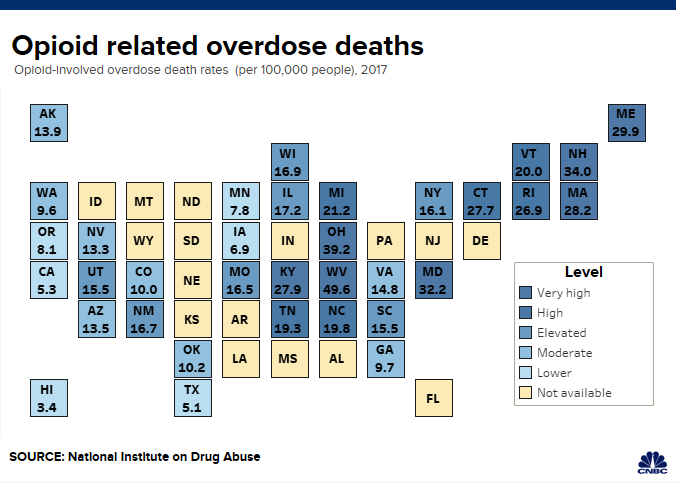Spencer Platt | Getty Images
Montgomery County, in southwest Ohio, is ground zero for the opioid crisis. The region has one of the highest overdose death rates in the country — mostly due to the illicit use of these narcotics. This statewide plague has rocked communities as prison populations for drug offenders swell. It has employers grappling with ways to hire and keep their workforces productive and in lockstep with economic demand.
It’s not surprising that the state has one of the largest female prison populations in the country. Experts agree addiction has been fueling this rapid growth. Thirty-five percent of all charges against women in the last decade were drug related.
“Now 70% of the children in Ohio child welfare programs have opioid-involved parents, and it is overwhelming the system,” says David Royer, CEO of the Alcohol, Drug and Mental Health Board of Franklin County in Columbus.
Statistics paint a bleak picture. About 5,000 people die from opioid overdoses in Ohio each year. The crisis is costing Ohio between $4 billion and $5 billion a year and hurting its competitiveness due to low marks on health. It has spurred Republican Gov. Mike DeWine to take a multiprong approach to the problem, including tracking the drug distribution chain in his state and waging a legal battle to stop the huge pill spill with the help of attorney Mike Moore, the man behind the multibillion-dollar tobacco settlement in 1998.
Ohio’s Republican governor, Mike DeWine
Tony Dejak | AP
The first targets are opioid manufacturers like Purdue Pharma, which makes OxyContin, and big drug distributor McKesson. The goal is to win billions in settlements and bankrupt the companies at the root of the problem.
It’s a quest that has inspired other states to follow suit. Now 48 states have filed lawsuits against Purdue Pharma, accusing the company of helping to ignite the nationwide opioid crisis. Moore is representing three of those states in addition to Ohio.

Beyond the courtroom, some of Ohio’s actions are being used as a model by other states and companies facing rising addiction rates. Among initiatives is the Ohio Opioid Education Alliance, a group formed last year that consists of 60 organizations that include companies, trade associations and small business owners that are committed to preventing the next generation of Ohioans from getting addicted to opioids.
“The alliance includes a worker coalition and an investor group and has raised $5 million to fund a variety of programs. One is a slick ad campaign created by Ogilvy to educate citizens about the risks of opioids and how they can get help for addiction and other mental health issues,” says Royer.
At a march in Norwalk, Ohio, Barry Bova holds a picture of his son Brad, who died of a heroin overdose.
Spencer Platt | Getty Images
Among its supporters in the private sector are Nationwide Foundation, Ingram-White Castle Foundation and American Electric Power.
As he explained, “states need to have a long-term public health strategy on this issue, not a short-term fix. This epidemic has spilled into the American workforce, because once you hire an employee, you inherit their family — and their issues.”
Today 75% of U.S. employers across the country have been affected by the opioid crisis, but only a startling 17% feel prepared to deal with it, according to research by the National Safety Council, a nonprofit that focuses on worker safety. It’s a devastating truth that has rocked companies of all sizes — from large Fortune 500 multinationals to small mom-and-pops.
Prescription painkiller abuse costs employers almost $42 billion in lost productivity alone every year, the NSC reports. If you add the health costs associated with addiction, that price tag rises astronomically.
Republican Gov. Mike DeWine is taking a multiprong approach to the problem, including targeting opiod distributor Purdue Pharma, maker of OxyContin, and big drug distributor McKesson.
George Frey | Reuters
All industries and professions are being affected, but the industries seeing the biggest hit: construction, manufacturing and retail.
“It’s time for employers to stop living in denial,” says Kathleen Herath, associate vice president for well-being and safety at Nationwide Insurance in Columbus. “Over the last six to seven years, U.S. businesses have seen a big increase in health costs due to substance abuse. Despite the trend, most are not addressing the problem.”
More from America’s Top States for Business:
These 10 states are America’s worst places to live in 2019
Why Pennsylvania is offering a child savings plan for every baby born in the state
Wyoming may hold the key to the rare earth minerals trade war with China
While Washington and state legislators are now taking action, their slow response to the epidemic has allowed the problem to spiral out of control, helping to fuel a $13 billion industry. Today a vast network of pain clinics has sprung up across the country. Access to opioids has never been easier, thanks to bitcoin and the Dark Web. Today addicts can easily buy opioids through their apps with on-demand delivery in minutes. It has touched everyone — from those in the boardroom to the assembly line.
“It [opioid overdoses] claimed more lives in America than motor vehicle crashes and gun violence last year,” reveals Rachael Cooper, senior program manager at the NSC. “It’s been increasing yearly due to a wave of heroin and fentanyl usage.
In this Nov. 2, 2017, file photo, Cincinnati Fire Department medics nasally administer naloxone to a woman while responding to a possible overdose report at a gas station in downtown Cincinnati.
John Minchillo | AP
Now businesses are trying to cope with the fallout. Nationwide Mutual Insurance based in Columbus has taken a lead in developing a corporate approach to address opioid addiction in the workforce that is being emulated across the country. It has all levels of employees involved — from the C-suite and managers to the rank-and-file. The company’s multipronged approach includes clean drug testing before making a hire; setting up a centralized drug hotline for employees managed by a case manager; and a second-chance policy that keeps drug addicts employed if they agree to treatment and random drug testing for two years. The company also trains managers on how to spot drug abuse among their workers and how to deal with the problem.
Its practices are taught through the Ohio Opioid Education Alliance. One that has made a big difference is giving every employee a drug disposal pouch that provides an easy way for them to deactivate and dispose of unused, expired or unneeded medications in their own home.
“It’s makes a big difference,” says Herath. “The key is to prevent misuse and get the drugs out of the house before it destroys their lives and the lives of their family.”
According to Herath, all these measures have yielded great results. In Nationwide’s experience, 100% of the workers who completed a two-year program maintained sobriety, and 60% were rehabilitated and came back to work.
It’s a case study of hope for U.S. employers willing to invest in the future of their workforces.
Chris Swift, the CEO of The Hartford who sees the toll this epidemic is having on company bottom lines, agrees this is a crisis that needs immediate attention. His company is working with the state of Connecticut and the federal government to develop national practices for this type of substance abuse. The Hartford website now also has a calculator that can determine the cost of addiction in a workplace based on size of employee base, industry and state.
As he explains: “We look at this as a long-term disability and a key employee benefit. Our research shows 56% of substance abusers are employed.”
 EU News Digest Latest News & Updates
EU News Digest Latest News & Updates



